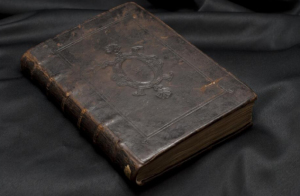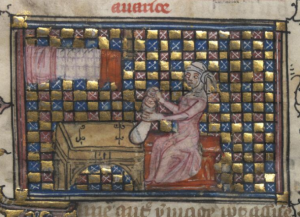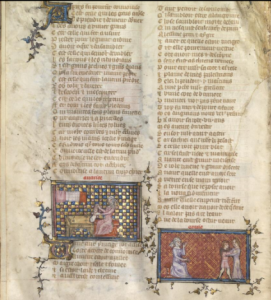The medieval manuscript Romance of the Rose contains the most popular romance poem of the fourteenth century. It was originally written by Guillaume de Lorris, who died before its completion, and the manuscript was later finished by Jean de Meun around the year 1280 (Aberystwyth, National Library of Wales, NLW MS 5016D). In addition to being considered as one of the most influential poems of the middle ages, it has also been deemed one of the most beautiful manuscripts of its time (Aberystwyth, National Library of Wales, NLW MS 5016D). The manuscript contains one hundred fifty folios made of expensive vellum, and its text is in brown ink, along with several miniatures and gilded capital letters throughout the text (Aberystwyth, National Library of Wales, NLW MS 5016D). The high quality of this manuscript is reflective of its literary importance; only a truly influential text would have the material context and excellent condition of Romance of the Rose.
The manuscript is printed on vellum, and although calfskin is a very common material for manuscripts, producing it uses up many resources and takes many hours to make. The time and effort put into creating this manuscript highlights how extremely important it was in medieval times. Unfortunately, it was rebound in the sixteenth century, but otherwise the manuscript is still in very good condition as the pages are not cropped, which usually happens to manuscripts when they receive new pasteboard bindings (Aberystwyth, National Library of Wales, NLW MS 5016D). The rebinding by Lortic of Paris is on “five bands, red morocco, with doublures of blue morocco, also richly tooled in blind and in gilt, and blue washed silk” (Huws). The highly expensive materials used to make the binding is not only representative of the wealth of its owner, but also of the noteworthiness of Romance of the Rose. When considering the care taken to preserve and maintain the quality of the manuscript, it is clear how significant this work is; its condition helps the reader understand how highly regarded it was in the thirteenth and fourteenth centuries. The beauty of the manuscript itself leaves all those who interact with it aware of its inherent importance and relevance.
materials used to make the binding is not only representative of the wealth of its owner, but also of the noteworthiness of Romance of the Rose. When considering the care taken to preserve and maintain the quality of the manuscript, it is clear how significant this work is; its condition helps the reader understand how highly regarded it was in the thirteenth and fourteenth centuries. The beauty of the manuscript itself leaves all those who interact with it aware of its inherent importance and relevance.
The subject of the manuscript’s poem is “courtly love” and the journey of the main character, otherwise known as the Lover, embarks on to find his true love (Aberystwyth, National Library of Wales, NLW MS 5016D). The poem is an “allegorical dream vision,” where the maiden, the object of the Lover’s affections, is portrayed as a beautiful rose and the walled garden she lives in represents the strict courtly society of that time (Aberystwyth, National Library of Wales, NLW MS 5016D). The Lover encounters several allegorical characters such as and Sadness, Pleasure, and Venus, the Roman goddess of love, who all teach
 him the “philosophy of love” (Aberystwyth, National Library of Wales, NLW MS 5016D). On folio 146r, there is a miniature of the maiden in the garden, which helps the audience of the manuscript gain a deeper understanding of the poem’s metaphor (Aberystwyth, National Library of Wales, NLW MS 5016D, fol. 5r). After de Meun became the new author, he took a more cynical and realistic approach toward love, which is a perspective shared by many in the latter part of the thirteenth century (Aberystwyth, National Library of Wales, NLW MS 5016D). de Meun’s ideas about love helps present-day readers understand the widespread beliefs of medieval people regarding love; the text, along with the ideas it holds, further emphasizes why the manuscript is easily identifiable as important.
him the “philosophy of love” (Aberystwyth, National Library of Wales, NLW MS 5016D). On folio 146r, there is a miniature of the maiden in the garden, which helps the audience of the manuscript gain a deeper understanding of the poem’s metaphor (Aberystwyth, National Library of Wales, NLW MS 5016D, fol. 5r). After de Meun became the new author, he took a more cynical and realistic approach toward love, which is a perspective shared by many in the latter part of the thirteenth century (Aberystwyth, National Library of Wales, NLW MS 5016D). de Meun’s ideas about love helps present-day readers understand the widespread beliefs of medieval people regarding love; the text, along with the ideas it holds, further emphasizes why the manuscript is easily identifiable as important.
Unlike other medieval manuscripts, which were typically written for religious purposes and as a form of catechism, Romance of the Rose has no specific audience or known owner; rather, it was simply a romantic poem. Despite that, it had an enormous effect on medieval literature as it was available to people of all educational backgrounds. Romance of the Rose is believed to have inspired the works of medieval greats such as Dafydd ap Gwilym and even Geoffrey Chaucer, who is accredited for translating a part of the French poem into Middle English (Aberystwyth, National Library of Wales, NLW MS 5016D).
The text is interspersed with intricately detailed miniature paintings; although the written text would usually only be understood by the literate people of the upper class, the images help the common people understand the meaning and plot of the poem. The text’s accessibility to people of all levels of education helps cause its widespread importance and influence. The ink used for the text and images is also indicative of its impact; throughout the manuscript, a variety of colors, like turquoise, flesh, gold, green, grey, and white, are used to ink the folios, which is visible in the miniature on folio 3v (Huws). Typically, red and blue ink were the most common and cheapest to use. In the middle ages, colored ink was always significantly more expensive, so the idea that someone would spend very large sums of money on colored ink for the manuscript shows how crucial is was to society at the time. The quality of materials used to create Romance of the Rose leads current readers to interpret the manuscript as one that is of high importance.


Aberystwyth, National Library of Wales, NLW MS 5016D, fol. 3v
Works Cited
Aberystwyth, National Library of Wales, NLW MS 5016D.
Huws, Daniel. “NLW MS 5014D.” The Romance of the Rose Illuminated: Manuscripts at the National Library of Wales Aberystwyth. Ed. Alcuin Blamires and Gail C. Holian. Tempe: Arizona Center for Medieval and Renaissance Studies, 2002. 115-17.